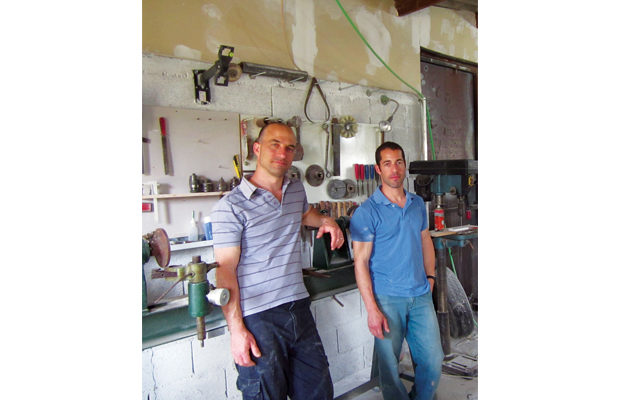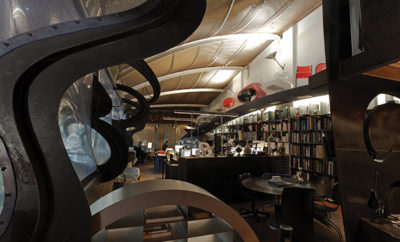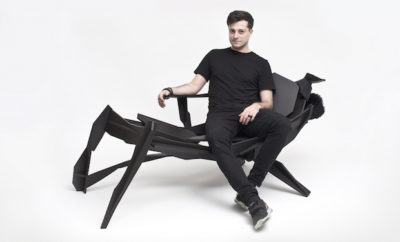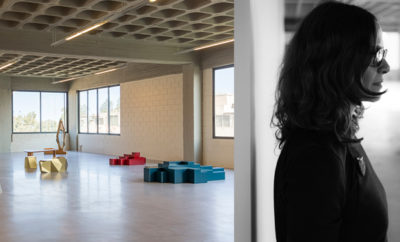 Goldner (left) and Geva in the chicken-house-turned-foam factory on Kibbutz Reshafim in Israel where they sometimes work.
Goldner (left) and Geva in the chicken-house-turned-foam factory on Kibbutz Reshafim in Israel where they sometimes work.
Design
Taking Risks in Creative Design
An innovative duo combines industrial techniques with craftsmanship and high design
Designers Gal Goldner and Iftah Geva thrive on pushing boundaries—not only merging technology with design concepts, but also working without a designated studio or schedule. The two men create complex furniture, jewelry, and sculpture at night and on weekends in a diverse trio of locations in Israel—their laptop computers at home; a former chicken coop-turned-polystyrene-foam facility on their northern kibbutz; and a drone aircraft factory in the south of the country. “Each location serves a particular purpose and we work whenever we can,” Goldner says. “The computer is essential for our original three-dimensional designs, and the other places offer the specialized machinery we need, from the unique wood CNC (Computer Numerical Control) milling machine to the equipment for the final polishing by hand.”

The duo’s Solar Plexus table of birch wood and carbon fiber, like the Jihad table, was created over a period of three years, and first shown at the New York Salon in 2012.
Unknown to the design world before 2012, Geva and Goldner had developed techniques for carving local woods into undulating curves and organic shapes, animated by industrial carbon fiber. They were discovered on a trip to Israel by Daniella Ohad, a New York–based design historian and consultant and director of the collecting design program at the New York School of Interior Design. Ohad recalls that she was impressed by their unusual choice of materials. “The result is a unique, personal aesthetic that can be defined as a fusion of two opposites—high tech and craft—but with the hand of the makers always visible in the sleek, streamlined forms,” she says. “Efforts to adopt materials and technologies from other sophisticated sectors to design is seen everywhere, but Goldner and Geva have done it successfully.” She compares the way they have used technologies from the drone industry for their furniture designs to Charles Eames, who famously adopted the molded plywood he had used in developing leg splints for the U.S. Navy to his furniture.
Born thirty-seven years ago on neighboring kibbutzim in Israel’s fertile Beit She’an Valley beneath Mount Gilboa, Geva and Goldner had comparable experiences growing up close to nature and helping out in the kibbutz fields, chicken coops, and fish farms. They also learned their way around tools: “I tried welding in the blacksmith’s shop at the age of twelve,” Geva says. Both recognize the influence of their early surroundings and later travels on their creativity. “I think the abstract inspiration for our work comes from within us—from where we grew up and what we absorb in our lives,” Goldner adds.
The two met after high school and went on to serve in the same unit for their mandatory army service. Afterward they toured Australia together by motorcycle and Jeep and then Goldner continued on to New Zealand followed by ten months in Chicago. Geva, meanwhile, returned to Israel and worked in a drone aircraft factory, where he honed his knowledge of machinery and metalworking. He also discovered the fabric-like material carbon fiber: “I was fascinated by its light and flexible properties,” he says. “I saw the creative possibilities of using it in combination with wood.” He enrolled in the industrial design program at the Holon Institute of Technology, in Israel where he found the first year enlightening and stimulating but was disappointed by the second year’s practical aspects. He left, brimming with ideas and armed with the belief that he could create remarkable pieces marrying art, design, and function, unshackled by tradition.
Goldner, back in Israel and studying mechanical engineering, cut back on his courses (it took him two additional years to graduate) to partner with Geva in forming a company they called GGI to implement their ideas. They produced a number of successful, innovative products, including one for chopping onions without tears, a next-generation playground, a drone-launcher, and more.

The black and white kinetic sculpture is titled Relations to symbolize human connections of different kinds. Measuring one meter in diameter, the sculpture is constructed of painted carbon fiber that has been polished to a high gloss. Internal weights help balance it at a critical angle.
Nowadays they divide their time between two enterprises: Life Assistant Ltd., which designs technologies and products to aid the disabled and elderly and GoldnerGeva, which focuses on design and art—furniture, jewelry, and sculpture. Geva is the artist and designer while Goldner handles the studio’s business side, but they share decision-making and the practical aspects of sculpting and sanding.
The first furniture collection from GoldnerGeva received outstanding reviews at the New York Salon: Art and Design show in 2012. Their Inside Out series of three tables embodies their personal philosophy of balance and harmony in work and life. Each represents a different aspect of deep inner search transformed into matter. The fifty-one-inch diameter Solar Plexus table represents different levels of the mind expressed as a perfect circle, but concealing corners and empty spaces. It began as a thousand pounds of thick sheets of raw birch plywood and took two thousand hours to complete. Ninety-five percent of the original material was meticulously sculpted away to create spaces that were reinforced with carbon fiber painted black. “There were times when we were faced with the unexpected complexity of the process,” Goldner says. “Instead of discarding it, though, we kept innovating and turned it to an advantage.”
Geva chose olive wood for the Jihad table, taking the literal translation of the word jihad—“effort”—to represent the spiritual sense of human beings aspiring to inner balance. The table requires effort to maintain equilibrium when placing objects on its top. The Anicca table, still in model form, represents the Buddhist term implying constant change. Its sculptural curves transform from dark to light, inside out and from top to bottom.
“Their work is so much on the cusp of what can be done that some pieces couldn’t be completed until technology caught up with their design concepts,” says Robert Aibel, owner and director of Philadelphia’s Moderne Gallery, which represents the pair. “Their use of beautiful wood and organic design elements clearly relate to the work of Nakashima, Esherick, Maloof, Ebner, and Castle in our gallery.”

Geva and Goldner’s first bracelet, seen here in two views, is in the permanent collection of the Museum of Arts and Design in New York.
When Israeli-based multidisciplinary artist Ilana Goor saw Geva and Goldner’s tables at Moderne, she suggested that they apply their furniture techniques to creating jewelry. Their first bracelet was acquired by New York’s Museum of Arts and Design in 2012, and in 2013 they launched a second series of jewelry in olive wood and carbon fiber, some of which incorporates gold inlaid into the wood grain.
Dale Anderson, a noted collector and co-founder of the Association of Israel’s Decorative Arts (AIDA), which promotes Israeli artists in the United States, says: “It is tremendously exciting to see such sophisticated contemporary design and craftsmanship coming out of Israel. This small country is producing many talented designers in different fields.”
Geva and Goldner continue to develop new furniture forms, including a pair of stools, and they say they are planning a second series of tables to be called Duo to symbolize the relationships between couples. Meanwhile, their kinetic sculpture, launched in New York in May 2014, presents their latest challenge to the ways we perceive the boundaries of design.












